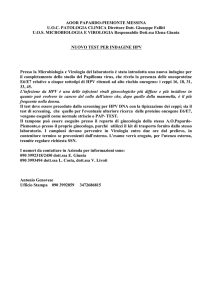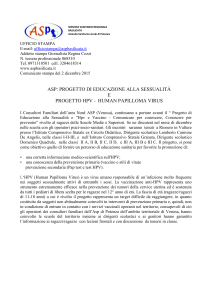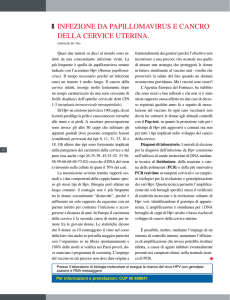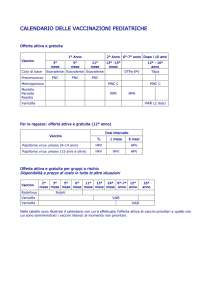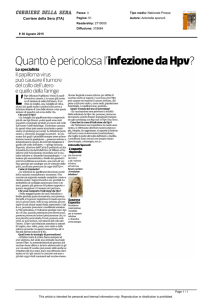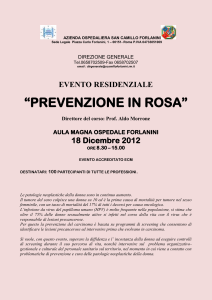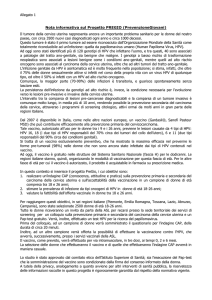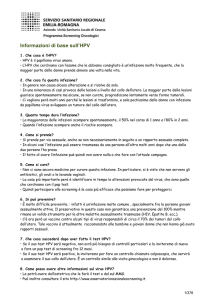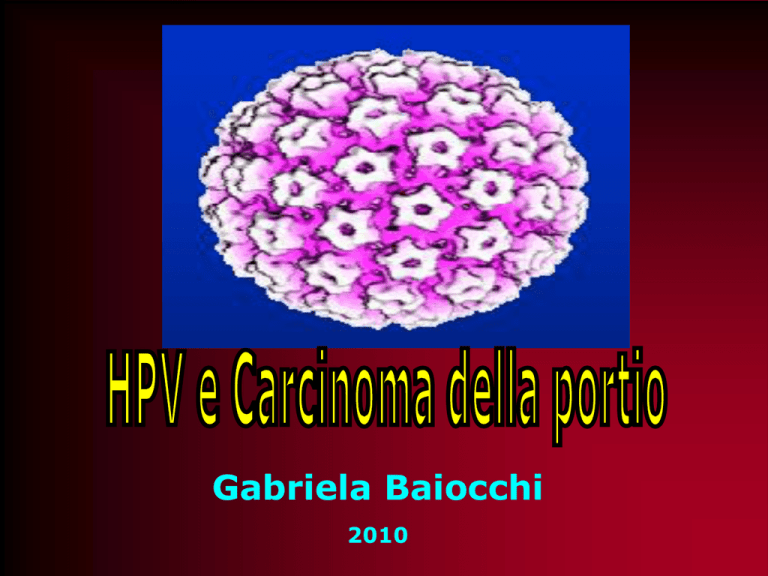
Gabriela Baiocchi
2010
L’INTERESSE
ANNI ’80: L’INFEZIONE DA PARTE DI GENOTIPI
DI HPV (PAPILLOMA VIRUS UMANO) AD ALTO
RISCHIO E’ UN FATTORE NECESSARIO ALLA
GENESI DEL CARCINOMA DELLA CERVICE
La struttura:
• virus a DNA
• due proteine
capsidiche
immunogene L1-L2
• quattro oncogeni
E1-E2-E6-E7
• Epidemiologia delle infezioni da
• HPV
•
I PAPILLOMAVIRUS:
•
Sono virus a DNA a doppia elica contenuti in un
• capside icosaedrico di 55 nm di diametro.
•
Ne esistono oltre 200 tipi di cui 100 ben
• caratterizzati.
•
Sono strettamente specie specifici e più di 100
• tipi infettano l’uomo.
•
Oltre 40 tipi infettano le mucose genitali e di
• essi circa 15 sono definiti a rischio oncogeno.
Capsid Protien L1
has high
immunogenicity
HPV Structure
• Small DNA viruses
with about 7900 base
pairs
• 6 early (E) and 2 late
(L) proteins
• L1-capsid protein
• **E6 and E7 are
oncogenic
www.rrpwebsite.org/hpvvac1.htm
transmission
• HPV HPV
is spread
by direct
physical contact.
• Any genital contact is
important, not just sexual
intercourse.
• Hand to genital contact
may cause some
infections.
• Anyone who is sexually
active is at risk.
• The risk of acquiring HPV
increases with the number Computerised image of the human papillomavirus
Courtesy of Dept of Pathology, University of Cambridge
of sexual partners.
6
Anogenital HPV Types
• “Low-risk” types:
6,11,40,42,43,44,53,54,61,72,73,81
• “High-risk” types:
16,18,31,33,35,39,45,51,52,56,58,59,68,82
• Possible “high-risk” types: 26, 66,73
HPV : Life cycle
1. HPV infetta le cellule dello strato basale dove
esiste in forma episomale ed esprime solo le
proteine “precoci”
2. Le cellule basali infettate dall’HPV hanno un
vantaggio proliferativo e si espandono
lateralmente
3. Le cellule infettate dall’HPV progrediscono
attraverso gli strati cellulari più differenziati
dell’epitelio
4. La replicazione virale aumenta e vengono
prodotte una grande quantità di copie di DNA
virale
HPV : Life cycle
1 . I geni che codificano per le proteine
“tardive” si attivano a livello degli starti più
superficiali dell’epitelio e i virioni vengono
assemblati.
2. Tali eventi determinano i caratteristici
effetti citopatici del virus:
1. 1. multinucleazione
2. 2. allargamento del nucleo
3. 3. ipercromia
4. 4. alone chiaro perinucleare (Koilocita)
Virus Penetrates Cervix
Papillomavirus
Uterus
Layers of
epithelial cells
Cervix
HPV
infection
Vagina
HPV infection in the cervix
11
Early proteins that regulate the virus are expressed in lowest layers of
epithelium
Late proteins are expressed in upper layers of epithelium
Viral nucleic acid can be found in basal stem cells, but late gene
expression(capsid proteins) is restricted to the uppermost layer of
differentiated keratinocytes.
ONCOGENESI
I meccanismi implicati
nell’oncogenesi son associati con le
proteine espresse precocemente E6 –
E7
Interferiscono con il ciclo cellulare,
danneggiano il DNA e inducono la
replicazione cellulare anche se il
DNA è danneggiato
HPV
Virology
G0: quiescent state
HPV
P53+E6 pRB+E7
p53
pRB
Cells exit
cycle here
Non-stop
proliferation
G1: gap
phase
G1: gap
phase
M phase:
mitosis
S phase: DNA
synthesis
G2: gap
phase
Nonproliferating cell
M phase:
mitosis
S phase: DNA
synthesis
G2: gap
phase
HPV stimulates proliferation
HPV E7 Protein
• The major transforming
and immortalizing
activity of HPV
• Cooperates with
activated ras oncogene
• Contains binding site for
Rb gene product and Rblike pocket proteins
• E7 binding to Rb blocks
the tumor suppressor
gene function of Rb
HPV E6 Protein
• Relatively weak ability
for independent
transformation and
immortalization
• Enhances the effects of
the E7 protein
• Binds to and inactivates
endogenous p53
• p53 normally plays role
as a transcription factor
and tumor suppressor
gene
Why can’t our immune system
respond to HPV infection
adequately?
MECCANISMI PER EVADERE LA
RISPOSTA IMMUNE
• HPV :
• Non litico
• Evade i segnali infiammatori che
attivano le cellule dendritiche
• Le proteine virali non vengono
secrete
• In Summary, HPV efficiently
evades the innate immune
response and delays the
activation of the adaptive
immune response.
• L’infezione da HPV
•
•
•
•
•
E’ la più comune delle infezioni a trasmissione
sessuale e la trasmissione può avvenire anche tramite
semplice contatto nell’area genitale. Il profilattico
riduce il rischio, ma non protegge completamente
dall’infezione.
Il 50-80% dei soggetti sessualmente attivi si
infetta nel corso della vita con un virus HPV e fino al
50% si infetta con un tipo oncogeno.
L’80-90% delle infezioni sono transitorie,
asintomatiche e guariscono spontaneamente.
L’infezione persistente con HPV oncogeni è la
condizione necessaria per l’evoluzione a carcinoma.
Il DNA dell’HPV è presente nel 99.7% dei
carcinomi cervicali.
• Adolescence/young age
Risk
Factors
• Early onset of sexual activity (at or before age
17)
• Number/risk status of sexual partners
(greater than 5/”high risk males”)
• Oral contraceptives
• Cigarette smoking
• **Lack of screening (women who have had
Pap smears at least every 3 years have 1/10
the risk of invasive disease of women who
have never had one)
• Immunosuppression
Risk Factors for HPV Infection
Sexual
Activity
Multiple
Partners
Younger
age at
sexual
debut
Ley C. J Natl Cancer Inst. 1991; Winer RL. N Engl J Med. 2006; Ho GYF. N Engl J Med. 1998.
Lack of
condom
use
•
•
•
•
•
•
•
•
•
•
HPV è ubiquitario
L’Esposizione inizia molto precocemente
• Circa il 70-80% degli uomini e delle donne
sessualmente attivi contrae l’infezione da HPV
in
qualche momento della propria vita
• La maggioranza delle infezioni sono
asimtomatiche e si risolvono spontaneamente
• L’infezione da HPV avviene poco dopo il
primo
rapporto sessuale.
• Oggi i rapporti sessuali iniziano precocemente:
HPV infection via
wounds in epithelium
HPV
Transformation Zones and HPV
Infection
• Area where one type of epithelium contacts
and gradually replaces another through
process of metaplasia
• Present in cervix, anus, tonsils
• Areas of HPV-related carcinogenesis
Moscicki AB. Vaccine. 2006.
Adolescent Susceptibility to HPV
• Low production of cervical mucus
• Incomplete local immunity
• Immature columnar epithelium in transformation zone
Squamocolumnar
Junction (SCJ)
External
Os
Cervical Transformation Zone
Source: http://www.merckmedicus.com/ppdocs/us/hcp/diseasemodules/hpvd/images/figure25.jpg
Before puberty
After puberty and
reproductive period
child-bearing period
Peri-menopausal period
menopausal period
Mechanism of HPV Transmission
& Acquisition
Sexual Contact
– Sexual Intercourse ( including anal)
– Genital-genital, manual genital, oral genital
– Genital HPV transmission in virgins is rare
but may occur through non-penetrative sexual
contact
Mechanism of HPV Transmission
& Acquisition
Nonsexual Contact
– Mother to newborn (vertical transmission, rare)
– Fomites (I.e.underwear, surgical gloves, biopsy
forceps). Hypothesized but not well
documented.
Risk Factors for HPV Infection
• Young age (less than 25 years old)
• Increasing number of sex partners
• Early age at first intercourse (16 years old
or younger)
• Male partner has (or has had) multiple sex
partners
PROCESSO MULTIFASICO (10-20 aa)
Eventi principali della cancerogenesi
da HPV
• Infezione da HPV ad alto rischio
E6, E7
p53
• Persistenza dell’infezione (integrazione del
DNA virale con il DNA della cellula ospite)
• Iperproliferazione, instabilità cromosomica, resistenza alla
differenziazione
• Modificazioni genetiche che si sviluppano nel tempo,
lesioni precancerose
Natural History of HPV & Cervical Cancer
Persistence
Normal
Cervix
Infection
Clearance
Progression
HPV
Infection
Invasion
Pre-cancer
Regression
Courtesy of M. Schiffman, National Cancer Institute.
Cancer
Natural History of Cervical
Carcinogenesis
La Piramide di Koutsky
(popolazione femminile U.S.A. 1997)
lesioni clinicamente manifeste
1%
lesoni subcliniche
HPV DNA pos
4%
100%
10%
90%
75%
80%
presenza di anticorpi
60%
70%
60%
50%
40%
nessuna infezione
30%
20%
10%
0%
25%
Natural History of HPV Infection
Persistent infection critical for development of
neoplastic change
Storia Naturale
HPV e carcinoma della cervice
INFEZIONE PERSISTENTE (10%)
5 anni
Displasia / CIN
CIN 1
Scompare
spontaneamente
nel 60% dei casi
40%
CIN 2-3
Scompare
spontaneamente
nel 30% dei casi
1% carcinoma
Età media donne con carcinoma cervice 48 aa
20 anni
Possibili esiti di un’infezione da
HPV
Infezione da HPV
a basso rischio
ad alto rischio
6, 11, altri
16, 18, altri
Condilomi genitali
Infezione cervice
Terapia
CIN I/II
CIN II/III
Regressione
Carcinoma
cervice
Regressione
INFEZIONE DA HPV
PERSISTENZA-PROGRESSIONE
DIPENDE da:
•
•
•
•
Tipo HPV
• Carica virale
• Sistema immunitario
• Fumo
Verruca comune
CLINICA DELLE INFEZIONI
Verruca del cavo orale, papillomi
laringei, carcinoma dell’orofaringe
Condilomatosi ano-genitale
VIN,VaIN, CIN, AIN
Low risk
(6,11,
42,43)
High risk
(16,18,
45,46)
Episoma
CONDILOMA
Proliferazione
Integrazione
Trasformazione
CIN
VaIN
VIN
AIN
CARCINOMA DELLA CERVICE UTERINA
Carcinoma della vulva e del pene
• Il carcinoma e’ un esito raro di una
• infezione
•
Per ogni milione di donne infettate
• con un qualunque tipo di HPV:
•
100.000 svilupperanno un’anomalia
citologica
• cervicale
•
8.000 svilupperanno un CIN III (ca in
situ)
•
1.600 svilupperanno un carcinoma della
cervice
Percentage of different cancers caused by
HPV
Percentage of different cancer types caused
by high-risk HPV types
Cancer site
Cervix
Percentage of
cases caused by
HPV
> 99%
Penis
40%
Vulva, vagina
40%
Anus
90%
Mouth
3%
Oropharynx
12%
Source: Prof Margaret Stanley, University of Cambridge
47
Classification Terminology for Cervical
Cytology: The 2001 Bethesda System
Normal1
ASCUS2
LSIL3
HSIL3
Two types of atypical squamous cells (ASC)4
Atypical squamous cells of undetermined significance (ASCUS)
Atypical squamous cells, cannot exclude high-grade squamous
intraepithelial lesions (ASC-H)
Squamous intraepithelial lesions (SIL)4
Low-grade SIL (LSIL): Mild dysplasia, cervical intraepithelial
neoplasia 1 (CIN 1)
High-grade SIL (HSIL): Moderate and severe dysplasia, CIN 2/3,
carcinoma in situ (CIS)
1. Spitzer M, Johnson C. Philadelphia, Pa: WB Saunders Co; 2002:41–72. Copyright © 2000 by WB Saunders Company.
Reprinted with the permission of Elsevier. 2. Apgar BS, Zoschnick L. Am Fam Physician. 2003;68:1992–1998. Reprinted
with the permission of the American Academy of Family Physicians. 3. Cannistra SA, Niloff JM. N Engl J Med.
1996;334:1030–1038. Images reproduced courtesy of Dr. Graziella Abu-Jawdeh. 4. Solomon D, Davey D, Kurman R, et
al, for the Forum Group Members and the Bethesda 2001 Workshop. JAMA. 2002;287:2114–2119.
Classification of Histological Findings:
Cervical Intraepithelial Neoplasia
Cervical intraepithelial neoplasia (CIN)1
CIN 1: Mild dysplasia; includes condyloma (anogenital warts)
CIN 2: Moderate dysplasia
CIN 3: Severe dysplasia; includes CIS
CIN1
Normal
CIN 1
(condyloma)
CIN 1
(mild
dysplasia)
CIN 2
(moderate
dysplasia)
CIN 3
(severe dysplasia/CIS)
Invasive
Cancer
Histology of
squamous
cervical
epithelium1
Basal cell
Basal membrane
CIN caused by HPV can clear without treatment;
however, rates of regression are dependent on grade of
CIN.2
1. Bonnez W. In: Richman DD, Whitley RJ, Hayden FJ, eds. Washington, DC: American Society for Microbiology Press;
2002:557–596. Reprinted with the permission of the American Society for Microbiology Press. 2. Ostor AG. Int J Gynecol
Pathol. 1993;12:186–192.
Classification of an abnormal papanicolaou smear
(According to the standard of the 2001 Bethesda classification of cytologic abnormalities )
squamous epithelial cell abnormalities glandular epithelial cell
abnormalities
Atypical squamous cells of
undetermined significance
(ASCUS) cannot exclude
HSIL(ASC-H)
Low-grade squamous
intraepithelial lesion(LSIL)
encompassing:human
papillomavirus/mild
High-grade squamous
intraepithelial lesion(HSIL)
encompassing:moderate and
server dysplasia, carcinoma in
situ; CIN2 and CIN3
Atypical glandular
cells(AGC)(specify endocervical,
endometrial, or not otherwise
specified)
Atypical glandular cells, favor
neoplastic (specify endocervical,
or not otherwise specified)
Endocervical adenocarcinoma in
situ(AIS)
Adenocarcinoma
Conventional Pap Smear
Decrease
Sensitivity
Colposcopy
• At colposcopy, the original or native squamous
epithelium appears gray and homogeneous. The
columnar epithelium appears red and grapelike.
The transformation zone can be identified by the
presence of gland openings that are not covered by
the squamous metaplasia and by the paler color of
the metaplastic epithelium compared with the
original squamous epithelium.Normal blood
vessels branch like a tree.
Carcinoma della Cervice
Il carcinoma della cervice è la seconda neoplasia per
incidenza nella popolazione mondiale femminile dopo il
tumore della mammella, con un incidenza di
493.000nuovi casi l’anno e una mortalità di 274.000
CA cancer J Clinic 2005
INCIDENCE and MORTALITY
• The prevention of cervical cancer is one of the most
successful examples of cancer control and prevention.
• Cervical cancer-related mortality has decreased
dramatically during the last 80 years from 30/100.000
in 1930 to 3.8 per 100.000 in 2000
• Since 1982 cervical cancer-related mortality rates have
declined 1.5% per year.
• There is a significant discrepancy in the incidence of
cervical cancer and in cancer-related mortality among
different minorities in the United States and different
countries in the world.
CERVICAL CANCER
• Tasso di incidenza di 12,3/100.000
donne/anno
• In Italia, ogni anno si osservano 3700 casi
di cui 1700 muoiono (45%)
• Mediante lo screening il tasso di incidenza
è calato del 40% dal 1976 al a1987
• Tassi di incidenza più elevati nelle aree
meridionali, a più basso livello economico
sanitario e tra le donne più anziane (>54
anni)
Cervical Cancer: Have we decreased the incidence ?
Reprinted by
permission of
the American
Cancer
Society, Inc.
• With the advent of • The curve has been stable for
the past decade because we
the Pap smear,
are not reaching the
the incidence of
unscreened population.
cervical cancer
has dramatically
declined.
STAGING
• In contrast to cancer of the uterus and
ovary, which are surgically staged,
carcinoma of the cervix is clinically
staged.
• FIGO (Montreal 1994) propose a staging
classification of carcinoma of the cervix.
• The cancer-related mortality, which is 0%
and 3% for stage 0 to 1B, escalates very
rapidly
Stage 0 CIN III, carcinoma in situ
Stage I
The carcinoma is strictly confined to the cervix
I A Invasive carcinoma which can be diagnosed only by
microscopy
I A 1 measured stromal invasion of not > 3 mm in depth and
extension of not > 7 mm
I A 2 measured stromal invasion of > 3 and not > 5 mm in depth
and extension of not > 7 mm
I B measured stromal invasion of > 5 mm in depth and extension
of > 7 mm; clinically visible lesions
I B 1 clinically visible lesions not > 4 cm
I B 2 clinically visible lesions > 4 cm
Stage II Cervical carcinoma invades beyond the uterus but not to the
pelvic wall or to the lower third of the vagina
II A no obvious parametrial involvement
II B obvious parametrial involvement
Stage III
The carcinoma has extended to the pelvic wall. On rectal
examination, there is no cancer-free space between the
tumor and the pelvic wall. The tumor involves the lower
third of the vagina. All cases with hydronephrosis or
nonfunctioning kidney are included, unless they are
known to be due to other cause.
III A tumor involves lower-third of the vagina, with no
extension to the pelvic wall.
III B extension to the pelvic wall and/or hydronephrosis or
nonfunctioning kidney
Stage IV
The carcinoma has extended beyond the true pelvis or
has involved ( biopsy-proven) the mucosa of the bladder
or rectum. A bullous edema, as such, does not permit a
case to stage IV.
IV A spread of the growth to adjacent organs
IV B spread to distant organs
FATTORI DI RISCHIO
PER CA CERVICE
•
•
•
•
•
•Inizio precoce attività sessuale
•Partners multipli
•Non uso contraccettivi barriera
•Giovane età prima gravidanza
•Immunodepressione (trapianti, dialisi, CT,
HIV)
• •Fumo sigarette
• •Non avere MAI fatto un pap test o non
sottoporsi a pap test per molto tempo
HPV e Carcinoma della
Cervice
Il Virus del Papilloma Umano (HPV)
è la causa necessaria per lo sviluppo
del Cancro del Collo dell’Utero
Rappresenta il più importante
Fattore di Rischio
HPV DNA è stato evidenziato nel 99,8%
dei Tumori del Collo del’Utero
Pathologic features
Squamous carcinoma
Adenocarcinoma
Adenosquamous carcinomas
Melanomas
Sarcomas
Patterns of spread
• Direct invasion cervical stroma, vagina,
and parametrium.
• Lymphatic spread pelvic and then
paraaortic lymph nodes
• Hematogenous spread such as lungs,
liver, and bone
Treatment of cervical cancer
Stage II
• Stage IIa
• Stage IIb
radical surgery or chemoradiation therapy
No operation. Combination of external beam
chemoradiation and intracavitary therapy.
Stage III
• Stage IIIa and IIIb
Chemoradiation therapy, usually
external beam followed by intracavity brachytherapy.
Stage IV
• Stage IVa
• Stage IVb
Pelvic chemoradiation therapy.
Some pelvic radiation therapy to control
bleeding from the vagina, and chemotherapy is for distant
metastases.
•
•
•
•
•
•
•
•
•
HPV e Malattie ad esso associate
HPV causa il 12% di tutti I tumori nelle donne,
20%-25% nei Pesi in via di sviluppo.
• Cancro cervicale uterino ed i suoi precursori
• Altri cancri genitali: vulva, vagina, pene, ano,
ed I loro precursori
• Il 13% dei cancri dell’orofaringe
• I Condilomi genitali
• La Papillomatosi Respiratoria Ricorrente
(RRP)
• • Alcuni Tumori della cute
• Malattie causate da HPV 6, 11, 16, e 18
• Tipo HPV Condizioni che si possono Prevenire
16 e 18
•
•
•
•
• 70-75% cancri cervice uterina
• 70% cancri anogenitali
• 52% delle lesioni pre-cancerose (CIN,VIN,VAIN)
• Molti Pap tests anomali
6 e 11
• • 90% dei condilomi genitali
• • 90% delle papillomatosi laringee
• AIS=adenocarcinoma in situ; CIN=cervical
intraepithelial neoplasia; VaIN=vaginal
intraepithelial
• 1. Evitare l’Infezione
• • Comportamento ed igiene
sessuale
• • Immunizzarsi contro il Virus
COME SI PREVIENE
L’INFEZIONE?
• SICUREZZA TOTALE:
• 1. Astinenza
• 2. Monogamia con partner monogamo
• SICUREZZA PARZIALE:
• 1. Condom
Strategies for the Prevention of
Cervical Cancers
IMMUNIZZARSI CONTRO IL VIRUS
Therapeutic Vaccine Prophylactic Vaccine
Human Papillomavirus(HPV) Vaccine
------The Anti-Cervical Cancer Vaccine
• The
First Vaccine Against Cancer
HPV - VACCINI
VACCINI:
E ’impossibile utilizzare
virus inattivati come
vaccino per l’uomo
Percio’ si sfrutta la
capacità immunogenica
dei singoli antigeni
capsidici(L1 e L2)
Si creano vaccini
PROFILATTICI
completamente privi di
rischio come vaccino ep.
B
L1 HA PIU’ ALTO POTERE IMMUNOGENICO
CON PRODUZIONE DI ANTICORPI HPV
SPECIFICI NELL’OSPITE
LE L1VPLs SONO GENOTIPO
SPECIFICHE E PROTEGGONO DAL TIPO
VIRALE DA CUI DERIVANO MA NON DA
ALTRI
Vaccino approvato sia dalla Food and Drug
Administration che dall’EMEA e già in commercio
anche in Italia
NOME COMMERCIALE: gardasil
DISTRIBUTORE: sanofi-pasteur
RANGE D’AZIONE: sierotipi 16,18,11,6
Attuale protocollo di applicazione
3 somministrazioni consecutive: 0, 2, 6 mesi i.m.
attualmente a pagamento con un costo di
circa 180 euro a somministrazione
HPV L1 VLP vaccine
Gardasil is a quadrivalent HPV-16/18/6/11
L1 VLP vaccine developed by Merck and Co.
Inc.
Cervarix is a bivalent HPV-16/18 L1 VLP
vaccine developed by
GlaxoSmithKline(GlaxoSmithKline
Biologicals, Rixensart, Belgium)
VACCINO PROFILATTICO
“IDEALE”
Dovrebbe rispondere ai seguenti
prerequisiti fondamentali:
1. Essere Multivalente
2. Conferire Protezione a Lungo Termine
3. Essere facilmente accettato dalla
popolazione
4. Dare garanzie di sicurezza e
immunogenicita
5. Poco costoso
VACCINI CORRENTI
• GARDASIL (VLP QUADRIVALENTE)
• Include i sottotipi : 6, 11, 16, 18
• Efficacia a prevenire CIN 2-3 associati con
questi sottotipi
• Efficacia a prevenire lesioni vulvari
• Efficacia a prevenire CIN 2-3 in donne
esposte al virus e poi sottoposte a
vaccinazione è drasticamente diminuita.
VACCINI CORRENTI
• CERVARIX (VLP BIVALENTE)
• Include i sottotipi : 16, 18
• Efficacia a prevenire CIN 2-3 associati
con questi sottotipi nel 95% dei casi
•
Gardasil
• Recombinant vaccine-prepared from purified viruslike particles (VLPs) of major capsid L1 HPV protein
• HPV types 16, 18 (high-risk) 6, 11 (low-risk)
• Efficacy mediated by humoral immune response
• IM administration, 0.5ml x 3 doses
-Day 1
-Day 1 + 2 months
-Day 1 + 6 months
• HPV or Pap testing not required prior to
administration
Cervarix®
• Cervarix® is a bivalent
vaccine manufactured
by GlaxoSmithKline.
• Cervarix® protects
against HPV types 16
and 18.
81
Vaccine schedule and
administration
• A vaccination schedule of 0,1-2, 6 months is
appropriate for Cervarix®.
• It is good practice to give all three doses, over 6
months.
• All three doses should be given within a 12month period.
• HPV vaccination is normally given by the usual
route, in the upper arm by IM injection.
82
The Vaccination
Cosa ci si aspetta dal vaccino
• 100% riduzione condilomi
• 90% riduzione lesioni preinvasive
cervicali
Koutsky, 2005
Ridurre la frequenza dei controlli citocolposcopici
Ridurre le terapie conservative per lesioni
preinvasive
CONTENIMENTO DEI COSTI
CHI VACCINARE?
Età target
• Le pre-adolescenti (9-13 anni)
[maggiore
• immunogenicità]
• • Le giovani donne in eta’ prescreening
• (18-19 anni) [picco dell’infezione]
• • Le giovani donne in eta’ di inizio
dello screening (25-26 anni)
Programmi di vaccinazione nel mondo
• USA, Agosto 2006: raccomandato per
bambine tra 11- 12 anni, può essere iniziato
sin dai 9 anni, recupero fino a 26 anni
• EU: raccomandato per bambine e ragazze
in Austria, Belgio, Danimarca, Francia,
Germania, Grecia, Italia, Lussemburgo,
Norvegia, Portogallo, Spagna, Svezia,
Svizzera, UK.
Programma di vaccinazione,
Italia
• Parere Consiglio Superiore di
Sanità, dell’11/01/07:
gratuito per le bambine nel dodicesimo
anno di età, considerare altre coorti (18
o 25 anni)
Programma di vaccinazione, Italia
•Conferenza Stato Regioni (intesa del
20.12.2007)
offerta attiva e gratuita
del vaccino anti-HPV alle ragazze nel corso del
dodicesimo anno di vita
(nel 2008: coorte ragazze nate nel 1997 )
attraverso le Strutture del SSN deputate
all’erogazione delle vaccinazioni
Coorti successive (13-26 anni)
• manca un’indicazione nazionale: ogni Regione ha
stabilito modalità differenziate di offerta
• strategia dell’occasione opportuna:
- proposta di vaccinazione in occasione di un accesso
alle strutture sanitarie per altro motivo
- abbinamento ad altre vaccinazioni (quando saranno
noti i dati di co-somministrazione con tetano-difteritepertosse, varicella)
VACCINI CORRENTI
• SICUREZZA
• Entrambi i vaccini sono ben tollerati.
• Effetti collaterali nel sito di iniezione:
eritema e lieve dolore
Vaccine-Related Adverse Effects
• Injection site reactions: (1-5 days )
-Pain > swelling > erythema > pruritus
-up to 85% of subjects
• Systemic effects (1-15 days)
- fever, nausea, nasopharyngitis,
dizziness,
-1-13% of subjects
Vaccine side effects
• Anaphylaxis following vaccination
is possible but extremely rare.
• Cases of less severe allergic
reactions should not be reported as
anaphylaxis but as 'allergic
reaction'.
92
Limitations of Vaccine
• 30% of cervical cancers not caused by
subtypes 16 and 18
• Duration of protection unclear-?
• **Pap screening still
required**
THE FUTURE:
Therapeutic Vaccine
DNA based vaccination protocol
aimed at inducing an efficient antiE7 immune response in the vivo.
DNA vaccine serving in treatment
of cervical cancer is at the cutting
edge of tummor immunotherapy.
• CONCLUSIONI (1)
• • L’Infezione da HPV e’ ubiquitaria e interessa
• almeno almeno 1 volta il 75% della
popolazione
• tra i 15 e i 49 anni.
• • La piu’ comune via di diffusione e’ quella
• sessuale (STD)
• • E’ responsabile di almeno 500.000 nuovi casi
di
• cervico-carcinoma ogni anno nel mondo
• • La presenza del virus si associa ad altre
forme
• tumorali maligne quali i cancri vulvari e
• vaginali, anali, oro-faringei, cutanei e laringei
• CONCLUSIONI (2)
• • L’Infezione da HPV è di solito asintomatica
ed innocua ed è per lo più transitoria
• • Alcune forme di HPV portano alla
condilomatosi
• cutanea, altre, definite ad alto rischio, possono
• portare, in tempi lunghi, fino al carcinoma
• cervicale.
• • Molto diverse sono le situazioni nei Paesi
• sviluppati ed in quelli in via di sviluppo.
• • Le campagne preventive sono fondamentali.
• CONCLUSIONI (3)
• • L’avvento della vaccinazione contro
alcuni tipi di HPV e la possibilità di
diagnosticare facilmente l’HPV ad elevato
rischio rappresentano una vera rivoluzione
non solo tecnica ma anche culturale e
cambieranno drasticamente le attuali
strategie preventive

